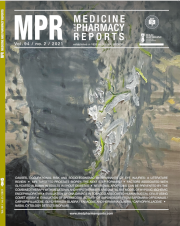A clinicopathological study of peripheral schwannomas
DOI:
https://doi.org/10.15386/mpr-1708Keywords:
peripheral schwannoma, histopathology, secondary changes, upper limb, nerve sheath tumourAbstract
Aim and objective. Schwannomas are benign neoplasms of neural origin with sporadic or syndromic occurence. They are commonly seen in cranial nerves. Peripheral schwannomas occur rarely and may have unique presentations. The aim of this study is to evaluate the clinico-pathological characteristics of peripheral schwannomas.
Methods. A retrospective cross sectional study of peripheral schwannomas excluding head neck region was conducted. The study group consisted of 18 cases which were recorded over a period of seven years. The corresponding data were collected from the archives of the Department of Pathology.
Results. Male to female ratio was 1:1. The average age of the cases was 47 years. The most common site was the upper limbs (55.55%) followed by lower limbs, chest and penis. The lesions mostly presented as painless swellings (62%). Histopathological examination revealed classic features of schwannoma. Secondary changes included cystic degeneration, foam cells, epitheloid cells, hyalinization, microcystic change and collection of plasma cells. All cases were confirmed by positive S100 staining.
Conclusion.Peripheral schwannomas may be missed due to its rarity and atypical presentations. Both clinicians and pathologists should be aware of this common entity at unusual sites for the proper management of the patients. Surgery is usually the treatment of choice.
Downloads
Published
How to Cite
Issue
Section
License
The authors are required to transfer the copyright of the published paper to the journal. This is done by agreeing to sign the Copyright Assignment Form. Whenever the case, authors are also required to send permissions to reproduce material (such as illustrations) from the copyright holder.

The papers published in the journal are licensed under a Creative Commons Attribution-NonCommercial-NoDerivatives 4.0 International License.

